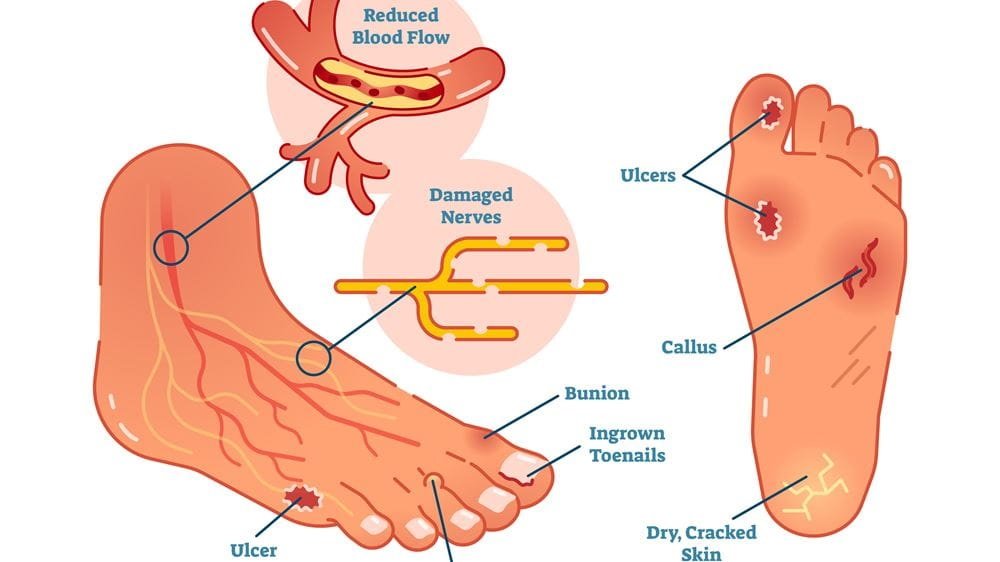Diabetic Foot Treatment in Rohini, Delhi by Dr. Ashok Tandon, Plastic Surgeon
Diabetes, a chronic metabolic disorder, affects millions worldwide, with its complications extending beyond blood sugar management. Among these complications, diabetic foot problems stand out as a significant concern. In Rohini, Delhi, individuals grappling with diabetic foot issues find solace in the expertise of Dr. Ashok Tandon, a distinguished Plastic Surgeon renowned for his adept handling of such cases.
Importance of Timely Treatment
The diabetic foot is a broad term encompassing various conditions stemming from nerve damage and poor blood circulation due to diabetes. Timely treatment is paramount as neglecting foot issues can lead to severe consequences, including infections, ulcers, and even amputations.
Understanding Diabetic Foot Ulcers

Diabetic foot ulcers are one of the most common complications encountered by individuals with diabetes. These ulcers typically develop on pressure points of the foot, such as the sole or sides, due to poor circulation and nerve damage. There are different types of ulcers, including neuropathic, ischemic, and neuroischemic ulcers, each requiring specific management approaches.
Types of Ulcers
- Neuropathic Ulcers: Result from nerve damage causing loss of sensation and increased pressure on certain areas of the foot.
- Ischemic Ulcers: Arise due to inadequate blood flow to the extremities, leading to tissue damage and ulcer formation.
- Neuroischemic Ulcers: A combination of neuropathic and ischemic factors contributing to ulcer development.
Causes
Several factors contribute to the formation of diabetic foot ulcers, including neuropathy, peripheral arterial disease, foot deformities, poor wound healing, and lifestyle factors like smoking and improper footwear.
Role of a Plastic Surgeon in Diabetic Foot Treatment in Rohini, Delhi
In the field of diabetic foot management, the expertise of a Plastic Surgeon like Dr. Ashok Tandon is invaluable. With specialized training in wound care, tissue reconstruction, and microsurgery, Dr. Tandon possesses the skills essential for addressing complex diabetic foot issues effectively.
Dr. Ashok Tandon’s Expertise
Dr. Tandon’s extensive experience in plastic and reconstructive surgery, coupled with his dedication to diabetic foot care, makes him a sought-after specialist in Rohini, Delhi, and beyond. His approach focuses on holistic patient care, combining surgical precision with compassion to ensure optimal outcomes.
Treatment Modalities
The treatment of diabetic foot complications necessitates a multidisciplinary approach, involving various modalities tailored to individual patient needs.
Surgical Interventions
In cases where conservative measures fail to yield results, surgical interventions may be required. Procedures such as debridement, skin grafting, flap reconstruction, and amputation may be performed to address ulcers, infections, and tissue necrosis effectively.
Non-surgical Approaches
Non-surgical interventions play a crucial role in diabetic foot management, encompassing wound dressings, offloading devices, orthotic inserts, and hyperbaric oxygen therapy to promote healing and prevent complications.
Preventive Measures
While effective treatment is essential, preventing diabetic foot complications is equally crucial. Patients are encouraged to adopt proactive measures to safeguard their foot health.
Foot Care Tips for Diabetics
- Inspect feet daily for cuts, blisters, and sores.
- Keep feet clean and moisturized, avoiding extremes of temperature.
- Wear comfortable, well-fitting shoes to minimize friction and pressure points.
- Avoid walking barefoot and trim toenails carefully to prevent injuries.
Lifestyle Modifications
Maintaining optimal blood sugar levels through diet, exercise, and medication adherence is paramount in preventing diabetic complications. Additionally, smoking cessation and regular foot examinations by healthcare professionals are recommended.
Patient Testimonials
Patients who have benefited from Dr. Ashok Tandon’s expertise attest to the life-changing impact of his interventions. Their testimonials serve as a testament to his commitment to excellence and patient-centered care.
Why Choose Dr. Ashok Tandon
Dr. Tandon’s unparalleled expertise, compassionate approach, and track record of success make him the preferred choice for individuals seeking diabetic foot treatment in Rohini, Delhi, and neighboring areas.
Accessibility and Location
Located in Rohini, Delhi, Dr. Ashok Tandon’s clinic offers convenient access to individuals in need of specialized diabetic foot care. The clinic’s state-of-the-art facilities and patient-friendly environment ensure a comfortable experience for all.
Cost and Insurance Coverage
The cost of diabetic foot treatment in Rohini, Delhi at Dr. Ashok Tandon’s clinic varies depending on the specific procedures and interventions required. Patients are advised to inquire about insurance coverage and payment options during their initial consultation.
Frequently Asked Questions (FAQs)
- How long does diabetic foot treatment typically take?
- Treatment duration varies depending on the severity of the condition and the chosen interventions. Dr. Tandon will assess each case individually and provide personalized treatment plans.
- Is diabetic foot treatment covered by insurance?
- Many insurance plans provide coverage for diabetic foot treatment, but it’s advisable to check with your provider for confirmation of coverage and any associated costs.
- Are there any risks associated with diabetic foot surgery?
- Like any surgical procedure, diabetic foot surgery carries certain risks, including infection, poor wound healing, and nerve damage. However, Dr. Tandon takes every precaution to minimize these risks and ensure patient safety.
- Can diabetic foot complications be prevented?
- While not all complications can be prevented, adopting a proactive approach to foot care, maintaining optimal blood sugar levels, and seeking timely medical attention for any issues can significantly reduce the risk of diabetic foot complications.
- What sets Dr. Ashok Tandon apart from other practitioners?
- Dr. Tandon’s extensive experience, specialized training in plastic surgery, and unwavering commitment to patient care distinguish him as a leading authority in diabetic foot treatment in Rohini, Delhi.
Conclusion
In the field of diabetic foot treatment, timely intervention and expert care are paramount. Dr. Ashok Tandon, with his unparalleled expertise and compassionate approach, stands as a beacon of hope for individuals facing diabetic foot complications in Rohini, Delhi, and beyond. By prioritizing patient well-being and employing advanced treatment modalities, Dr. Tandon ensures optimal outcomes and improved quality of life for his patients.
